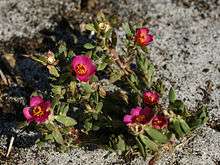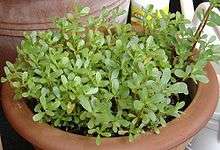Portulaca
| Portulaca | |
|---|---|
 | |
| Portulaca amilis | |
| Scientific classification | |
| Kingdom: | Plantae |
| Clade: | Angiosperms |
| Clade: | Eudicots |
| Order: | Caryophyllales |
| Family: | Portulacaceae |
| Genus: | Portulaca L.[1] |
| Species | |
|
about 40-100, see text | |
| Synonyms | |
|
Sedopsis (Engl.) Exell & Mendonça[1] | |
Portulaca (/ˌpɔːrtjuːˈleɪkə/,[2] purslane) is the type genus of the flowering plant family Portulacaceae, comprising about 40-100 species found in the tropics and warm temperate regions. They are also known as purslanes.


Common purslane (Portulaca oleracea) is widely considered an edible plant, and in some areas it is invasive. Some Portulaca species are used as food plants by the larvae of some Lepidoptera species including the Nutmeg (Hadula trifolii).
Purslane can be eaten raw or cooked, and lends itself to salads and lightly stir-fried dishes. When harvested early in the morning, the leaves and tender stems have a pleasant, mildly sour taste due to the overnight accumulation of malic acid, which is produced via CAM photosynthesis.[3] It is relatively easy to grow in more northern climates, including the New England area in the United States; it grows very well in hot and dry summer months: the plant's switch to CAM photosynthesis and nightly malic acid production is a response to drought stress.
Selected species
|
|
Formerly placed here
- Anacampseros arachnoides (Haw.) Sims (as P. arachnoides Haw.)
- Anacampseros filamentosa subsp. filamentosa (as P. filamentosa Haw.)
- Anacampseros lanceolata subsp. lanceolata (as P. lanceolata Haw.)
- Anacampseros rufescens (Haw.) Sweet (as P. rufescens Haw.)
- Anacampseros telephiastrum DC. (as P. anacampseros L.)
- Sesuvium portulacastrum (L.) L. (as P. portulacastrum L.)
- Talinum fruticosum (L.) Juss. (as P. fruticosa L. or P. triangularis Jacq.)
- Talinum paniculatum (Jacq.) Gaertn. (as P. paniculata Jacq. or P. patens L.)[5]
Gallery
 Purslane cultivar
Purslane cultivar Pickled purslane stems consumed in Armenia
Pickled purslane stems consumed in Armenia
References
| Wikimedia Commons has media related to Portulaca. |
| Wikispecies has information related to Portulaca |
- 1 2 "Genus: Portulaca L." Germplasm Resources Information Network. United States Department of Agriculture. 1998-04-28. Retrieved 2011-03-04.
- ↑ "Portulaca". Oxford English Dictionary (3rd ed.). Oxford University Press. September 2005. (Subscription or UK public library membership required.)
- ↑ Harold McGee. Tropical plants used as vegetables, in On Food and Cooking, Scribners, 2004 edition.https://www.amazon.com/dp/0684800012.
- ↑ "Portulaca". Integrated Taxonomic Information System. Retrieved 2011-03-04.
- 1 2 "Species Records of Portulaca". Germplasm Resources Information Network. United States Department of Agriculture. Retrieved 2011-03-04.
External links